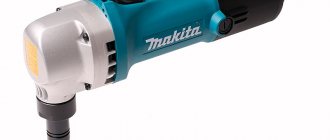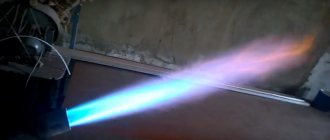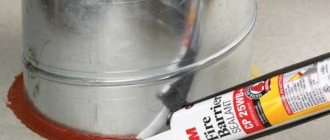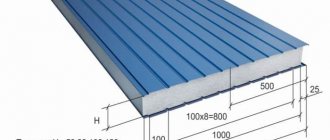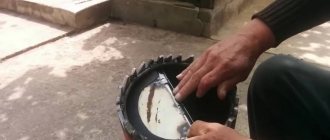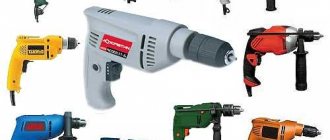The need to cut metal products arises in many situations related to construction and repair work. To perform this technological operation, special equipment of various types is used, but if it is not at hand, a drill attachment for cutting metal can help. Using such attachments and a hand-held electric drill, you can effectively cut thin products made from various metals.
Shaped cutting of metal tiles with a cutting attachment for a drill
Types of metal cutting equipment
You can cut a metal sheet or a more massive metal product using various equipment.
Angle grinder
This device is also known as an angle grinder. It can be used to cut rebar, thick sheet metal and other types of metal products. This is the most popular equipment used for such purposes.
Circular saw for metal
This saw allows you to make cuts at different angles and perform them with great precision. Meanwhile, when using this equipment, the resulting cuts have a limited depth and a large amount of waste is generated.
Guillotine
This is high-performance equipment for metal cutting, with the help of which workpieces of simple configurations are processed.
Band saw and jigsaw
This equipment allows you to make cuts at different angles. Both the jigsaw and the band saw, due to their design features, impose significant restrictions on the size of the products that need to be cut.
Hydraulic equipment
Equipment of this type is innovative. It allows you to cut metal with high precision, while the thickness of the processed product can reach up to 20–30 cm. The most significant disadvantage of this cutting method, in which the product is not subjected to thermal effects, is its high cost.
As mentioned above, you can also use drill attachments for cutting metal products, which are presented in a wide variety on the modern market.
Drill attachments can also be used for cutting other materials
Scissors
It is relatively easy to cut a smooth sheet with scissors, but with long cuts you have to find ways to install the material so as not to damage your hands or the workpiece. Complex configurations are difficult to produce; it is easier to move in a straight line. When using an angle grinder with cutting discs, the edge burns and unprotected metal remains on it.
Cutting a profiled sheet is much more difficult. The blades of scissors do not have enough grip angle, so craftsmen are forced to find ways to grip and cut metal.
Ideas to adapt existing tools to perform complex tinsmith work have been around for a long time. But not everyone is ready to purchase complex and expensive devices. It’s easier to use attachments for existing power tools.
Features of using drill attachments
The attachments, with the help of which a conventional electric drill is transformed into a device for cutting metal, are essentially a punch (cotter pin). Making numerous reciprocating movements in the internal cavity of the matrix, such a punch pierces a metal sheet, forming a cutting line on it, the width of which is 3.1 mm. When using attachments, a targeted effect is applied to the processing area, due to which the protective layers on the surface of the metal product fully retain all of their functions.
The working part of the cutting type nozzle
Using the drill attachment, you can cut metal sheets of the following thickness:
- made of aluminum - up to two millimeters;
- made of copper, brass, sheet iron, zinc and galvanized steel - up to one and a half millimeters;
- made of stainless steel - up to eight tenths of a millimeter.
The reciprocating motion of the punch, which is the main working body of the nozzle, is imparted by the rotation of the electric drill chuck. It should be borne in mind that such an attachment can effectively cut a metal sheet only if it is used in conjunction with an electric drill, the chuck of which rotates at a frequency of at least 2700 rpm.
Examples of cuts with a nozzle of galvanized sheet (0.55 mm) and aluminum (2 mm)
Safety precautions
Regardless of the brand of drill and attachment, their price and characteristics, it is very important to follow safety precautions.
Drill Safe Practices
This will prevent injury and damage to the material.
- When working with a drill, you need to wear safety glasses and gloves.
- Before starting work, it is important to check the attachment of the nozzle.
- Be sure to check whether the material to be cut is well secured.
- The drill must be held with both hands using special holders.
- When working with a metal cutting attachment, constantly remove falling chips. For example, when installing a roof, a large amount of chips can damage the surface of the metal tile.
- After completing the work, do not touch the treated metal with your hands for some time and remove the attachments, as they may heat up due to friction.
So, when we cut metal sheets up to 2 mm thick, for example, when installing metal tiles or a fence made of corrugated sheets, and the amount of work is small or one-time, then it makes sense to turn your attention to drill attachments.
Benefits of using drill attachments
Drill attachments, when compared with such a popular tool for cutting metal as an angle grinder, have a number of advantages.
- The cut performed is of high quality.
- When using a drill attachment for cutting metal, there is no need to purchase additional consumables, which significantly saves money.
- The use of such an attachment ensures high productivity of the cutting process.
- Drill attachments are highly versatile.
- Due to the fact that this tool is equipped with a special handle, the cutting process with its help is very convenient.
- These attachments are suitable for both electric and pneumatic drills.
- The convenience of these nozzles both in use and in maintenance is undeniable.
- With the help of such tools you can make cuts of almost any configuration.
Despite the simplicity of the design of such attachments, their use requires certain skills and dexterity from the user.
Stand assembly procedure
The structure is assembled in a certain sequence.
First, the lid is inserted into the body, into its upper half. To fasten it, you should align the radii of their holes. Fastening is provided by two screw bolts. Then a mounting ring is put on the neck of the tool itself, and the grinding head is clamped in the chuck. The housing is installed on top of the mounting ring. Again you will have to align the holes and fasten them with four screws. After installation, you can begin sharpening. To do this, turn on the drill. The drill must be fed into a suitable hole. Even an inexperienced craftsman can use such a stand.
Popular models and areas of their application
Modern models of drill attachments allow cutting sheet metal not only in a straight line. Using such a convenient and easy-to-use device, you can also make shaped cuts, which is often required when installing roofing structures, ventilation ducts, as well as gutters and other elements of the drainage system.
Using such attachments on a drill, cuts can be made in almost any spatial position. An equally important advantage of these attachments is that they do not require preliminary setup.
This attachment turns the drill into electric scissors that work on the principle of cutting, not carving.
Among the most popular models of drill attachments for cutting metal presented on the domestic market are the following:
- "Cricket" (from);
- Sparky NP 1.8L;
- EDMA NIBBLEX;
- ACCO YT-160A.
Perforated scissors-attachment for electric drill EDMA NIBBLEX for cutting metal and plastic
The differences between models of drill attachments do not lie in the principle of their operation, but in the maximum thickness of the metal being cut and a number of other technical characteristics. Modern models of drill attachments allow you to obtain smooth and neat cuts with sharp, even and uncrimped edges. In this case, the protective coating applied to the surface of the metal sheet is not damaged and fully retains all its functions.
"Cricket"
One of the popular attachments for a drill, which is a compact nibbler (nibbler), is a device called a “Cricket”. This attachment, which allows you to obtain an even and neat cut, can be used for cutting both flat and profile metal sheets.
The “Cricket” scissor attachment is designed to operate from a pneumatic or electric drill (screwdriver) with a power of at least 420 W
Using the Cricket scissor attachment, you can cut not only metal sheets, but thin-sheet products made of polycarbonate and other polymer materials. At the same time, the thickness of the products for cutting which these compact nibblers can be used can be up to:
- 1.5 mm – for steel sheet material;
- 1.2 mm – for stainless steel;
- 2 mm – for copper and aluminum, as well as polymer materials.
Using the “Cricket” drill attachment, you can cut sheet material in horizontal and vertical planes, as well as make internal cuts on the surface of the sheet.
“Cricket” works on the principle of nibbled scissors
It should be borne in mind that in the place of the sheet from where the internal cut will be made, it is necessary to pre-drill a hole.
“Cricket” is a good drill attachment for cutting metal tiles and corrugated sheets. When using this device for cutting metal, the surface of these materials is not deformed, and the cut itself is smooth and neat. The Cricket attachment can easily cope with such complex tasks as artistic cutting and creating large-diameter holes in sheet material.
Device for converting a drill into a circular saw and grinder
A special adapter can turn the drill not only into a real circular saw, but also into a grinder.
The device consists of a clamp that securely fixes the drill, a mount for a gear wheel or grinding wheel, and a platform measuring 75 × 85 × 11 mm, which is screwed to the surface of the work table.
All adapter parts are made of metal and are particularly durable.
Having such a device in his arsenal, the master, in addition to the drill, receives two more useful tools: a circular saw and a grinder.
Price - about 800 rubles.
9
Principles of sharpening drills
These works are carried out in accordance with the rules and using appropriate equipment. However, experienced professionals are able to restore sharpness on sharpening machines by holding the tool manually. Such work requires a lot of experience, otherwise the drill can easily be damaged.
There are a number of sharpening rules:
- The tip should be sanded for up to 2-3 seconds per approach. This is due to the “releasing” of the metal, which consists of a loss of hardness due to loss of hardening, with longer exposure due to heating. Evidence of this process is the presence of temperature discoloration on the edge.
- During mechanical sharpening, the edge should be directed towards the rotation of the sandpaper.
- The basic principles of sharpening are determined by the size and configuration of the tool. Thus, drills with a diameter of up to 4 mm should be held motionless during each approach. For spiral versions, only the back surface is sharpened.
- The sharpening angle is determined by the type of target material. Sometimes one fixture is re-sharpened depending on the target materials.
The frequency of sharpening is determined by the type of drill. Thus, specialized models for wood, including feather ones, are not sharpened at home. In addition, they slowly become dull. This is also true for carbide tools. Pobedite options designed for concrete cannot be restored at all. Thus, twist drills for metal are most often sharpened.
The latter are distinguished by a small edge, which intensively heats up from friction due to the small dispersion area. Overheating leads to dullness. Signs of this include creaking, rapid heating of the device without moving deeper, waste in the form of sawdust rather than curled shavings.
Using a dull drill leads to loss of efficiency and accelerated tool wear.
No need for extra sacrifices
The modern man has a lot of hand and power tools in his arsenal, which, at first glance, can do an excellent job of cutting anything. But when working with metal tiles, it is better to avoid unnecessary experiments. Let's take a closer look at some of the possible options.
What if you try to cut metal tiles using these tools:
- jigsaw? This tool is good for many things, but not for metal tiles - a jigsaw will tear it, and besides, it can break its saw;
- hand scissors for metal? You may get down to business right away, but after a while you will look for other options to cut metal. In fact, this is very difficult to do with hand tools;
- Bulgarian? Here it is, the most logical option that comes to mind. It cuts sheets with ease, however, there is a downside to the coin that needs to be described separately.
Types of sharpening devices
To properly sharpen a drill, you need to use special devices. They are divided into two categories:
- industrial equipment. Has great power. Using it, it is possible to sharpen drills with a radius of one centimeter. These devices are installed in large enterprises. Sharpening is performed semi-automatically/automatically;
- household equipment. Intended for use at home. In addition, it is used in small enterprises. This equipment is mobile, compact, and has standard power.
When purchasing a machine, you need to take into account the noise level and design features of the device. It is optimal to buy a regular machine, because it is easy to find suitable spare parts for it.
You only need to purchase sharpening devices in special places, because they come with a technical passport for the machine. In addition, the buyer receives a warranty card.
Why not Bulgarian?
If you carefully read the instructions for metal tiles and their installation, then, of course, you found a point where it is stated that cutting with a grinder is prohibited . In this case, the product warranty is simply voided. Why is that?
The metal tiles are protected on top by a special polymer that does not tolerate high temperatures. And when using an angle grinder, the metal will heat up just to those critical temperatures, so that both the zinc coating and the polymer layer will melt in certain places. The result is deformation of the protective layers; such tiles will be damaged by rust and may even leak.
In addition, sparks from the contact of the abrasive disc and the tiles will fly in different directions, causing damage . These points will become small, and in the future more dangerous islands of corrosion.
Advice: if you decide to cut with a grinder, then try to protect the tile sheets from sparks. And cover the cut areas with facade paint. Although this is not the best, it is a tolerable option.
How to do it yourself?
Most often, craftsmen need to make a special stand, since it is the most versatile of all devices. It can be used for straight drilling from top to bottom - vertical drilling at right angles. The maximum height of the bar for drilling is determined only by the height of the stand and the length of the drill.
A thick sheet of metal or chipboard up to 5 cm thick can be used as a frame (base). A profile with a square cross-section will serve as a stand. You can also take guides with the help of which ordinary drawers are pulled out and retracted. Then you won’t have to think about the mechanism for moving the drill. The carriage can be made from corners. A drill clamp is attached to it. For fastening, you can use ordinary clamps that fasten water pipes.
You can make a rack according to drawings available on the Internet.
Detailed step-by-step instructions on how to assemble a drill stand with your own hands can be seen in the video. Below are different options, so you can choose any one according to your taste.
